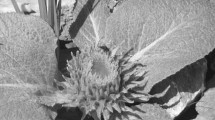Abstract.
Thymelaea hirsuta is a circum-Mediterranean subdioecious shrub used to model the evolutionary pathway from heterodichogamy to dioecy. Since discordant data on the pollination mechanism of this plant have been reported, in this study we have tried to clarify the complex of features and events involved in the breeding system of this species at the Northern edge of its range (Tyrrhenian coast, Italy and France). Flower and pollen features related to pollination mechanism were analyzed, and the seasonal presence of insects visiting the plant was monitored. Despite the presence of small pollen grains, normally associated with wind pollination, the Crotonoid-pattern of exine, the large amount of pollenkitt and the presence of nectar are typical entomophilous adaptations. Among insects visiting the plant, thrips (Thysanoptera) might have a role in pollination owing to their large number and for the constant presence of T. hirsuta pollen on their body. In contrast, no evidence of anemophilous transport of pollen was obtained, clashing with reports of a wind pollination system for Egyptian populations. Based on our observations wind seems not to play a key role in the pollination process of this species in the Northern Mediterranean region, while insects might play a major role.
Similar content being viewed by others
Author information
Authors and Affiliations
Corresponding author
Additional information
We are grateful to E. Pacini (Università di Siena) for a critical reading of the manuscript and his useful suggestions. We would like to thank R. Poggi (Museo Civico di Storia Naturale, Genova) and G. Pagliano (Museo Regionale di Scienze Naturali di Torino) for insect determinations. A particular thank goes to the Leica Microsystems technical staff for the use of the Leica DM5000B interference contrast microscope. This study was supported by a FIRB grant 
Rights and permissions
About this article
Cite this article
Cornara, L., Borghesi, B., Caporali, E. et al. Floral features and reproductive ecology in Thymelaea hirsuta (L.) Endl.. Plant Syst. Evol. 250, 157–172 (2005). https://doi.org/10.1007/s00606-004-0236-x
Received:
Accepted:
Published:
Issue Date:
DOI: https://doi.org/10.1007/s00606-004-0236-x




